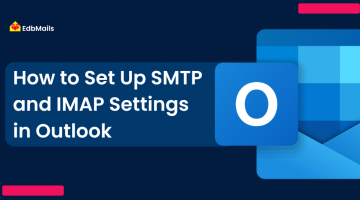Microsoft Exchange Server 2013 has served organizations reliably for over a decade. But with its end of support in April 2023, businesses are now exposed to potential security vulnerabilities, compliance risks, and increased maintenance costs.
This shift forces IT decision-makers to consider the next step: continue on-premises with a newer Exchange version or move to the cloud with Microsoft Office 365.
Regardless of the migration path—whether upgrading Exchange on-premises, moving to Office 365, or adopting a hybrid approach—every project comes with its own challenges. This is where EdbMails Exchange Migration and Office 365 Migration softwares prove invaluable. Purpose-built for reliability and simplicity, EdbMails delivers seamless, secure, and zero-downtime migrations. All mailboxes, public folders, and archives are transferred with complete fidelity, enabling organizations to modernize their email infrastructure without disrupting day-to-day operations.
Deployment Models: Choosing the Right Path with EdbMails Support
On-Premises Exchange 2013 to Newer Versions
Organizations that wish to retain full control of their email infrastructure often choose to upgrade to a newer on-premises Exchange server. Exchange 2016 and Exchange 2019 are the natural upgrade paths.
- Why upgrade? Staying on-premises ensures customization, strict compliance control, and internal data sovereignty.
- The challenge: Manual upgrades can be time-consuming and error-prone, especially when dealing with large mailboxes and legacy systems.
👉 With EdbMails Exchange Migration tool, you can directly migrate from Exchange 2013 to Exchange 2016 or Exchange 2019 without double hops or manual exports. The tool preserves folder hierarchy, permissions, calendars, contacts, and public folders.
🔗 Related resources:
Microsoft Office 365 (Cloud Deployment)
Office 365 offers a modern, cloud-first approach. Businesses no longer need to invest in servers or worry about hardware failures. Instead, they pay a predictable per-user subscription, gaining access to Exchange Online along with Teams, SharePoint, OneDrive, and Office applications.
- Why migrate? Office 365 improves scalability, remote work accessibility, and collaboration, while eliminating heavy IT overhead.
- The challenge: Large-scale migrations from Exchange 2013 can be risky without the right tools. Downtime, lost attachments, or broken folder structures can disrupt business operations.
👉 EdbMails Exchange Migration tool simplifies the process with:
- Cutover, staged, and hybrid migration support
- Incremental sync (no duplicate items)
- Zero downtime migration
Hybrid Deployment
A hybrid deployment combines on-premises Exchange 2013 with Office 365. Many large enterprises use this model to migrate gradually, maintain regulatory compliance, or test workloads before committing fully to the cloud.
EdbMails supports hybrid Exchange 2013 to Office 365 migrations, ensuring smooth coexistence and staged mailbox transfers. This allows IT teams to migrate executive mailboxes, shared mailboxes, or specific departments first before moving the entire organization.
Office 365 Tenant to Tenant Migration
Mergers, acquisitions, or restructuring often create a need to migrate between different Office 365 tenants. These migrations are among the most complex, as they involve mailboxes, OneDrive, Teams, and SharePoint data.
- The challenge: Native tools require multiple steps and manual intervention, leading to downtime and user disruption.
- The solution: EdbMails Office 365 Tenant-to-Tenant Migration tool simplifies this process by:
- Supporting direct tenant-to-tenant transfers without intermediate hops
- Maintaining permissions, folder hierarchy, shared mailboxes, and groups
- Offering incremental migration to avoid duplicates and save bandwidth
- Ensuring zero downtime so end users can continue working uninterrupted
👉 Learn more: Office 365 Tenant-to-Tenant Migration Guide
Exchange 2013 vs. Office 365: Feature Comparison
| Category | Exchange 2013 (On-Premises) | Office 365 (Cloud) |
| Message Size Limit | Configurable | 25 MB+ (plan-dependent) |
| Recipient Limits | Configurable | 1,500/day |
| Public Folders | Fully supported | Limited, modern groups recommended |
| Antivirus/Antispam | Customer-managed | Microsoft Defender, ATP |
| Storage | Hardware-dependent | Up to 100GB mailbox + auto-archiving |
| Accessibility | VPN required for remote users | Anywhere, any device |
With EdbMails Exchange Migration software, you can move all mailbox components including emails, attachments, tasks, notes, contacts, calendars, public folders, and archive mailboxes without any data loss.
Pricing Comparison: Exchange 2013 vs. Office 365
Exchange 2013 On-Premises Costs
- Hardware (servers, storage, backups)
- Licensing (Exchange CALs, Windows Server, etc.)
- Skilled IT staff salaries
- Maintenance, power, cooling, network costs
Office 365 Subscription Costs
- Microsoft 365 Business Basic – $6/user/month
- Microsoft 365 Business Standard – $12.50/user/month
- Microsoft 365 E3 – $36/user/month
Over time, Office 365 proves to be more cost-effective for growing organizations. Combined with EdbMails one-time lifetime license pricing, businesses save even more during the transition phase.
Migration Challenges and How EdbMails Solves Them
Without a dedicated migration tool, organizations often encounter:
- Downtime and potential data loss
- Interrupted user access during cutovers
- Compliance risks if sensitive data isn’t migrated correctly
- Complicated hybrid configurations that are difficult to manage
EdbMails Exchange Migration and Office 365 Migration software overcomes these issues with:
- Zero downtime – users can work seamlessly during migration
- Incremental sync – avoids duplicates and reduces migration time
- Advanced filtering – migrate data by sender, subject, or date range
- Detailed logging and reporting – ensures compliance and audit readiness
EdbMails Migration Software – Pricing and Benefits
EdbMails provides affordable and transparent pricing with a one-time license model—no recurring subscriptions.
- Exchange Migration Tool – Migrate directly from Exchange 2013 to 2016/2019 or Office 365
- Office 365 Migration Tool – Supports cutover, staged, hybrid, and tenant-to-tenant migrations
- Lifetime license starting at just $80 per migration project
- Free trial available (migrate up to 30 items per mailbox)
- 24/7 live technical support with migration experts
- One-time pricing model – saves thousands compared to subscription-based competitors
👉 Explore pricing:
Conclusion: Migrate from Exchange 2013 with Confidence Using EdbMails
Sticking with Exchange 2013 is no longer sustainable due to end-of-support, security risks, and rising costs. The best long-term options are:
- Upgrading to Exchange 2016/2019
- Migrating to Office 365
- Performing Tenant-to-Tenant migrations in cases of mergers or restructuring
With EdbMails Exchange Migration and Office 365 Migration software, you get:
- Direct migrations from Exchange 2013 to 2016, 2019, or Office 365
- Zero downtime, no data loss, and incremental sync for reliable performance
- Full support for Tenant-to-Tenant migrations
- Step-by-step guidance through detailed migration guide



